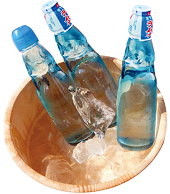Summer Memories: Ramune
 Gail Umehara / Wordsmith
Gail Umehara / Wordsmith
During her 16 years in Japan, Gail juggled raising a family with, amongst other things, working as a translation assistant, librarian, and editor. Back in Australia, she continues to work with words as an interpreter, editor and TAFE lecturer.
Summer Memories: Ramune
 Our long hot summer is over, but there are still plenty of festivals to look forward to over the coming months. In Japan, one thought that springs to mind when someone mentions the words 'summer' and 'festival' is cold fizzy Ramune. Like many things that seem so very Japanese, history shows that this soft drink and its special container both derive from the West. It is said that the first carbonated drinks to be served in Japan nearly caused an international incident in 1853, when the popping sound of the cork being removed from some American "soda water" made the samurai being entertained by Commodore Perry reach for their swords because they thought someone had fired a gun.
Our long hot summer is over, but there are still plenty of festivals to look forward to over the coming months. In Japan, one thought that springs to mind when someone mentions the words 'summer' and 'festival' is cold fizzy Ramune. Like many things that seem so very Japanese, history shows that this soft drink and its special container both derive from the West. It is said that the first carbonated drinks to be served in Japan nearly caused an international incident in 1853, when the popping sound of the cork being removed from some American "soda water" made the samurai being entertained by Commodore Perry reach for their swords because they thought someone had fired a gun.
The bottle lovingly associated with Ramune, however, was not invented until the 1870s. Hiram Codd, a British engineer working for a cork manufacturer, invented a new way of sealing bottles using a marble that was forced against an O-ring in the neck of the bottle by the pressure of the gas in the liquid contents by turning the bottles upside down immediately after filling. This method was so successful that it became one of the most popular bottling processes for soft drinks and beer throughout Britain, Europe, Asia, as well as Australia and Canada. But in 1892 an American engineer invented an even better sealing method, the crown cap (the kind of bottle cap we still use), and Codd-neck bottles mostly disappeared. Two countries, however, even now continue nostalgically to use this style of bottle for soft drinks: India and Japan.
Nagasaki claims to have been the first place to start up local production of soft drinks in 1865. By the 1880s several makers had entered the business around the country, especially in the port cities. The makers gave their products names like "citrus water", "soda" or "cider", but the name that gained such popularity that it came to be commonly used isラムネ (ra-mu-ne), a phonetic approximation of "lemonade". Over the years the original lemonade flavour has been joined by a range of fruit varieties as well as some rather more exotic ones, such as bubble gum, wasabi, kimchi, curry, and takoyaki, which are now exported from Japan to the rest of the world.

